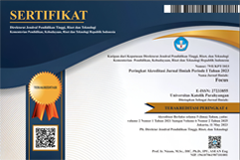Religious Legitimacy in Realizing Harmony in Indonesia
DOI:
https://doi.org/10.26593/focus.v2i2.5403Keywords:
Social interaction, Religious harmony, Fundamental rights, Textual analysisAbstract
This study aims to discuss religious harmony as a form of religious tolerance seen from the perspective of religions. The research methodology is qualitative, library research that uses a descriptive approach to explain religious harmony. The discussion of this research includes the notion of religious harmony, the principle of the trilogy of religious harmony, concepts, methods, guidelines and quality of religious harmony, the legal basis and objectives of religious harmony, the supporting and inhibiting factors for the occurrence of religious harmony and religious harmony from a spiritual perspective. This study concludes that religious harmony is a condition of interaction between individuals/groups in which various religious groups can live together without reducing the fundamental rights of each to carry out their religious obligations.
References
Ali, A. M. (1971). Alam Pikiran Islam Moden di Indonesia. Yayasan Nida.
Ali, A. M. (1991). Metode Memahami Agama Islam. Bulan Bintang.
Arianto, B. (2019). Memahami Front Pembela Islam: Gerakan Aksi Atau Negara Islam. Communitarian, 2(1).
Arifiansyah. (2018). Ilmu Perbandingan Agama Dari Regulasi ke Toleransi. Perdana Publishing.
Arifianto, Y. A., & Santo, J. C. (2020). Tinjauan Trilogi Kerukunan Umat Beragama Berdasarkan Perspektif Iman Kristen. Angelion: Jurnal Teologi Dan Pendidikan Kristen, 1(1), 1–14.
Arifianto, Y. A., Triposa, R., & Saptorini, S. (2021). Christian perspective on the tolerance of Christian religious education teachers and students in the era of disruption. KURIOS (Jurnal Teologi Dan Pendidikan Agama Kristen), 7(2), 381–391.
Effendi, M. R., Kahmad, D., Solihin, M., & Wibisono, M. Y. (2021). Relasi Agama dan Masyarakat: Studi Tentang Interaksi Masyarakat Bandung Barat dan Jamaah Tabligh. Hayula: Indonesian Journal of Multidisciplinary Islamic Studies, 5(1), 1–24.
Forouhari, S., Teshnizi, S. H., Ehrampoush, M. H., Mahmoodabad, S. S. M., Fallahzadeh, H., Tabei, S. Z., Mohammad, N., Mirzaei, M., Jahromi, B. N., & Teshnizi, S. M. H. (2019). Relationship between religious orientation, anxiety, and depression among college students: A systematic review and meta-analysis. Iranian Journal of Public Health, 48(1), 43.
Galtung, J. (2009). Theories of conflict: Definitions, dimensions, negations, formations. Hawai: University of Hawai.
Hanaviyah, J. (2018). Komunitas Lintas Tokoh Agama dalam Memelihara Kerukunan Umat Beragama (Studi pada Forum Kerukunan Umat Beragama Kabupaten Pesawaran). UIN Raden Intan Lampung.
Haq, M. Z. (2021). Hate Studies: The Urgency and Its Developments in the Perspective of Religious Studies. Jurnal Aristo (Social, Politic, Humaniora), 9(2), 375–395.
Jemal, A., Bussey, S., & Young, B. (2020). Steps to Racial Reconciliation: A Movement to Bridge the Racial Divide and Restore Humanity. Social Work & Christianity, 47(1).
Jirhanuddin. (2010). Perbandingan Agama: Pengantar Studi Memahami Agama-Agama. Pustaka Pelajar.
Lubis, R. (2005). Cetak Biru Peran Agama. Puslitbang Lektur dan Khazana Keagamaan Badan Litbang dan Diklat Kementerian ….
Malik, A., & Busrah, B. (2021). Relasi Pemerintah dan Akademisi dalam Isu Moderasi Beragama di Indonesia. Substantia: Jurnal Ilmu-Ilmu Ushuluddin, 23(2), 120–135. https://doi.org/10.22373/substantia.v23i2.9167
Maritain, J. (2005). An introduction to philosophy. Rowman & Littlefield.
Mohr, J. M. (2008). Hate studies through a constructivist and critical pedagogical approach. Journal of Hate Studies, 6(1), 65–80.
Nazmudin, N. (2017). Kerukunan dan Toleransi Antar Umat Beragama dalam Membangun Keutuhan Negara Kesatuan Republik Indonesia (NKRI). Journal of Government and Civil Society, 1(1), 23–39.
Nurdin, A. A., Jamaludin, A. N., Supriatna, E., & Kustana, K. (2019). The dynamic of religious life: A study of conflict and integration of Ahmadiyah in Garut, Tasikmalaya and Kuningan, West Java. Komunitas: International Journal of Indonesian Society and Culture, 11(1), 63–74.
O’Grady, K., & Jackson, R. (2020). “A touchy subject”: teaching and learning about difference in the religious education classroom. Journal of Beliefs & Values. https://doi.org/10.1080/13617672.2019.1614755
Pohan, R. A. (2014). Toleransi Inklusif. Kaukaba Dipantara.
Rahman, M. T. (2010). Pluralisme Politik. WAWASAN: Jurnal Ilmiah Agama Dan Sosial Budaya, 34(1), 1–13.
Rimmer, A. (2020). Breaking the silence: community radio, women, and empowerment. Community Development Journal. https://doi.org/10.1093/cdj/bsz030
Rusydi, I., & Zolehah, S. (2018). Makna Kerukunan Antar Umat Beragama Dalam Konteks Keislaman Dan Keindonesian. Al-Afkar, Journal For Islamic Studies, 1(1, January), 170–181.
Samosir, L., & Haq, M. Z. (2022). Fratelli Tutti : Brotherhood Without Boundaries. Jurnal Iman Dan Spiritualitas, 2(2), 267–270. https://doi.org/http://dx.doi.org/10.15575/jis.v2i2.17936
Sari, Y., Yustiana, S., Fironika, R., Ulia, N., Iasha, V., & ... (2022). The Design of Religious Value-Based Teaching Materials in Increasing Students’ Learning Achievement Elementary School. Jurnal Basicedu. https://jbasic.org/index.php/basicedu/article/view/2235
Shihab, A. (1998). Islam Inklusif Menuju Sikap Terbuka dalam Beragama. Mizan.
Vinkasari, E., Cahyani, E. T., Akbar, F. D., & Santoso, A. P. A. (2020). Toleransi Antar Umat Beragama Di Indonesia Untuk Mempertahankan Kerukunan. Prosiding Hubisintek, 1, 67.
Wibisono, M. Y., Truna, D. S., & Rahman, M. T. (2021). Turning religion from cause to reducer of panic during the COVID-19 pandemic. HTS Theological Studies, 77(4), 1–8.
Zahroh, L. (2020). Sejarah pemikiran modernisme Islam A. Mukti Ali: kerukunan umat beragama dan signifikansinya di Indonesia. UIN Sunan Ampel Surabaya.

Downloads
Published
Issue
Section
License
Copyright (c) 2022 FOCUS

This work is licensed under a Creative Commons Attribution-ShareAlike 4.0 International License.



















